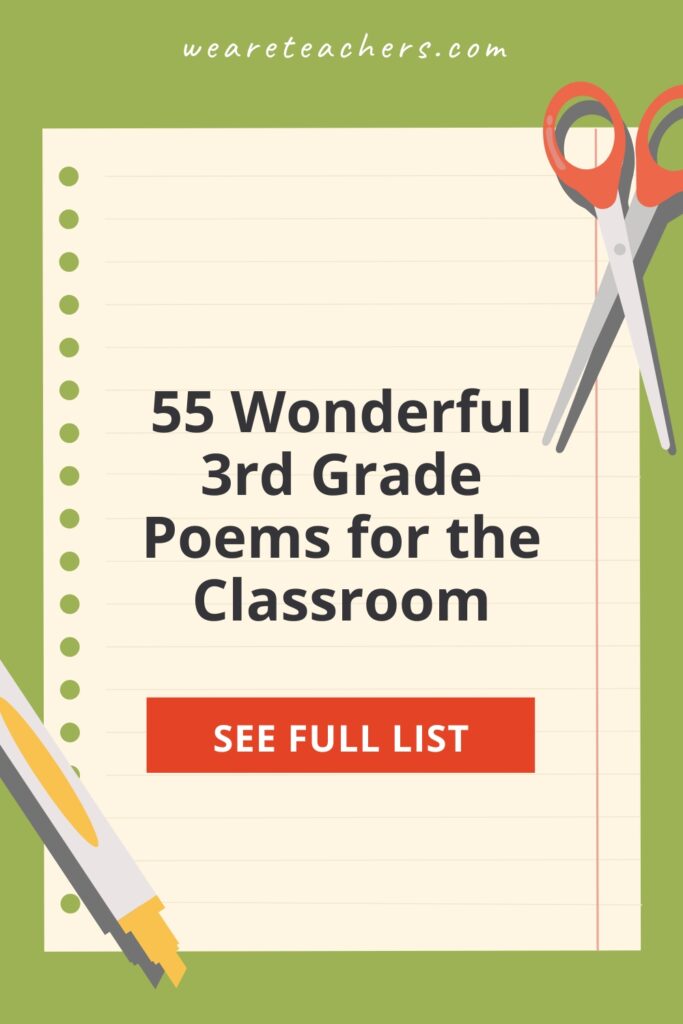There’s something so sweet about poems for 3rd graders. The kids are ready to tackle more complex themes and vocabulary, but the poetry is still so endearing and innocent. We’ve put together a list of engaging poems that will delight and spark a conversation among your 3rd grade students.
FREE PRINTABLE
Free Poetry Worksheet Bundle
Grab our poetry worksheet bundle to pair with your poetry unit and make teaching poetry fun and simple.
1. Daisies by Frank Dempster Sherman
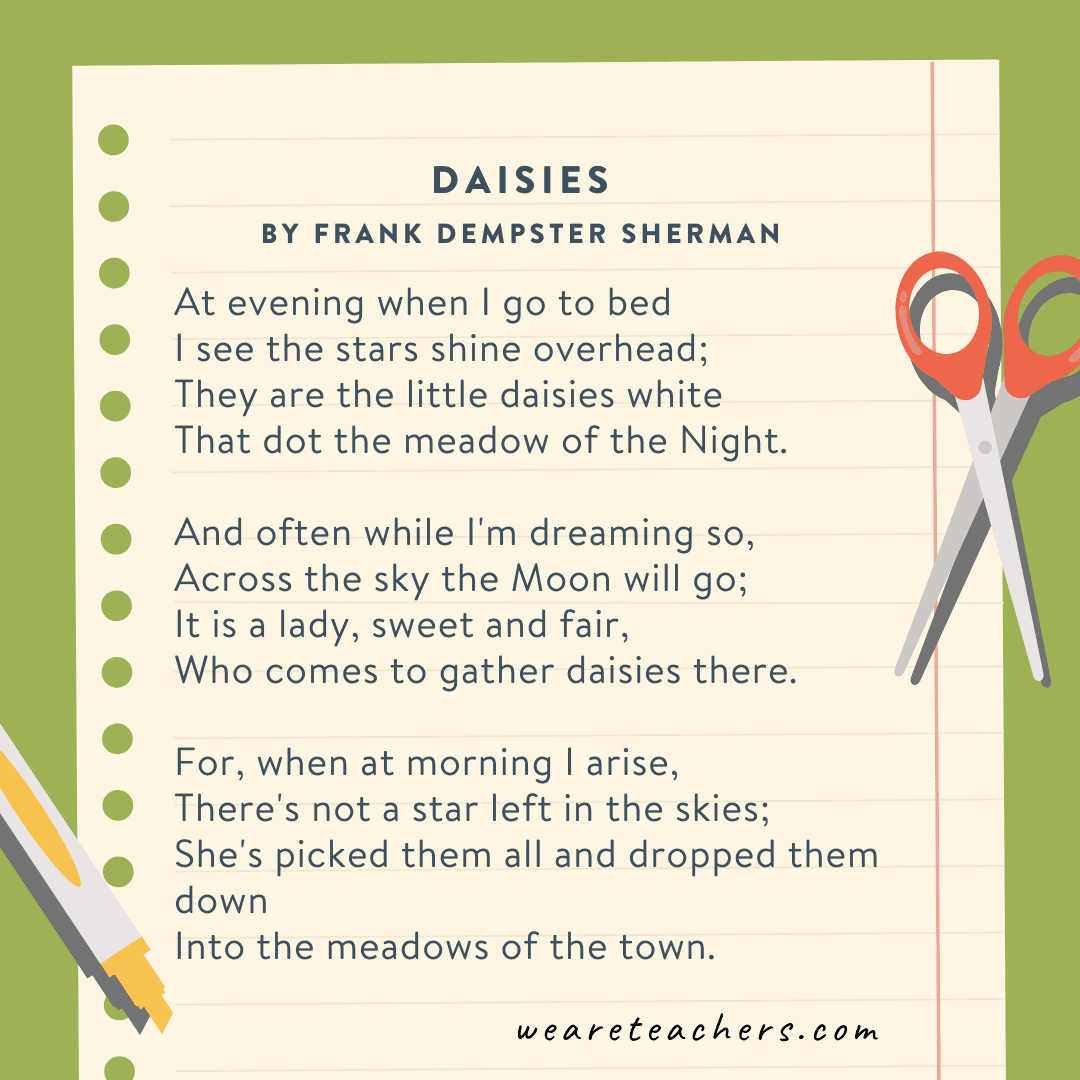
“It is a lady, sweet and fair, who comes to gather daisies there.”
Themes: Nature, beauty, appreciation
Literary devices: Imagery, personification, rhyme
This gentle poem paints a picturesque scene of a lady picking daisies, using vivid imagery and a melodic rhyme scheme. It’s a lovely choice for introducing students to traditional poetic structure while encouraging discussions about how nature is celebrated in poetry.
“The schools are now open but, this year, at mine, the teachers and students are meeting online.”
Themes: Adaptation, humor, modern life
Literary devices: Rhyme, tone, satire
This lighthearted poem captures the experience of online learning with humor and relatability. It’s great for discussing how poetry can reflect contemporary life and for exploring rhyme and tone in humorous poetry.
3. Little Rain by Elizabeth Madox Roberts
“When I was making myself a game, up in the garden, a little rain came.”
Themes: Childhood, nature, unexpected moments
Literary devices: Imagery, rhythm, simplicity
This short, sweet poem captures a child’s playful interaction with nature, making it a solid for discussing sensory details and how poetry can transform simple moments into something special.
“I’d take it, spare it, give it, share it, lend it, spend it, too.”
Themes: Generosity, love, kindness
Literary devices: Repetition, rhythm, parallelism
This uplifting poem emphasizes the idea of spreading love generously, using repetition and rhythm to create a flowing, musical effect. It’s a good way to discuss the power of poetic structure in reinforcing meaning and emotion.
5. To a Child by William Wordsworth
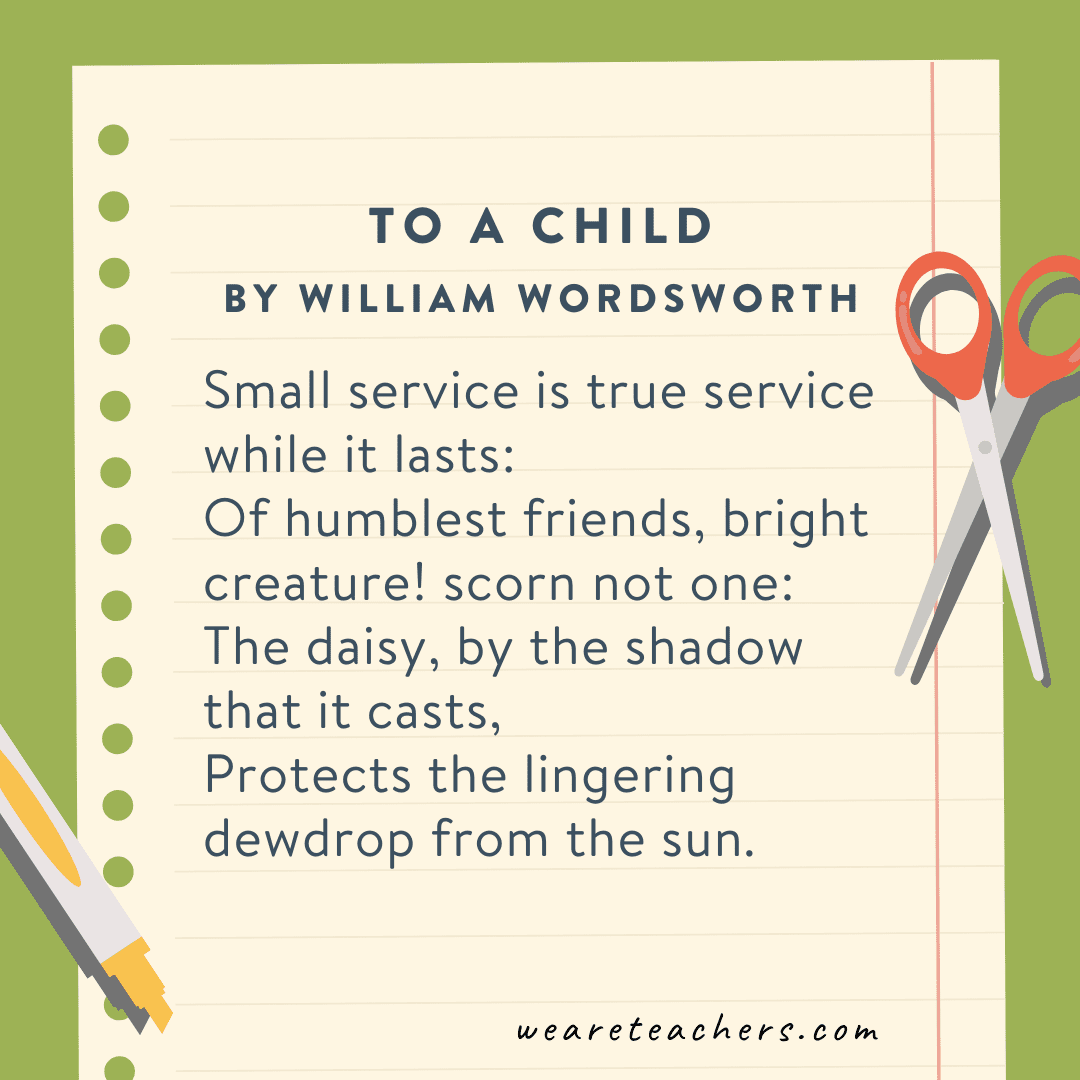
“Small service is true service while it lasts …”
Themes: Kindness, humility, wisdom
Literary devices: Aphorism, tone, metaphor
This thoughtful poem offers wisdom about the value of small acts of kindness, making it a great conversation starter about moral lessons in poetry. It’s also useful for exploring how poets use simple language to convey deep truths.
“Bad dogs barking loud, big ghosts in a cloud / Life doesn’t frighten me at all.”
Themes: Courage, resilience, childhood fears
Literary devices: Repetition, rhyme, imagery
This bold, rhythmic poem expresses confidence in the face of fear, using strong imagery and repetition to create a sense of empowerment. It’s perfect for discussions on how poetry can inspire resilience and self-assurance while also exploring rhythm and voice in poetry.
“On a bench, in Joe’s little shed, lying not too far apart, were his ax and his switchblade, having a quiet heart-to-heart.”
Themes: Strength vs. precision, wisdom, storytelling
Literary devices: Personification, dialogue, metaphor
This clever poem turns tools into characters, using personification to explore the contrast between brute strength and sharp precision. It’s an interesting way to introduce students to metaphor and symbolism while sparking discussions on how objects can tell a story.
8. The Eagle by Alfred, Lord Tennyson
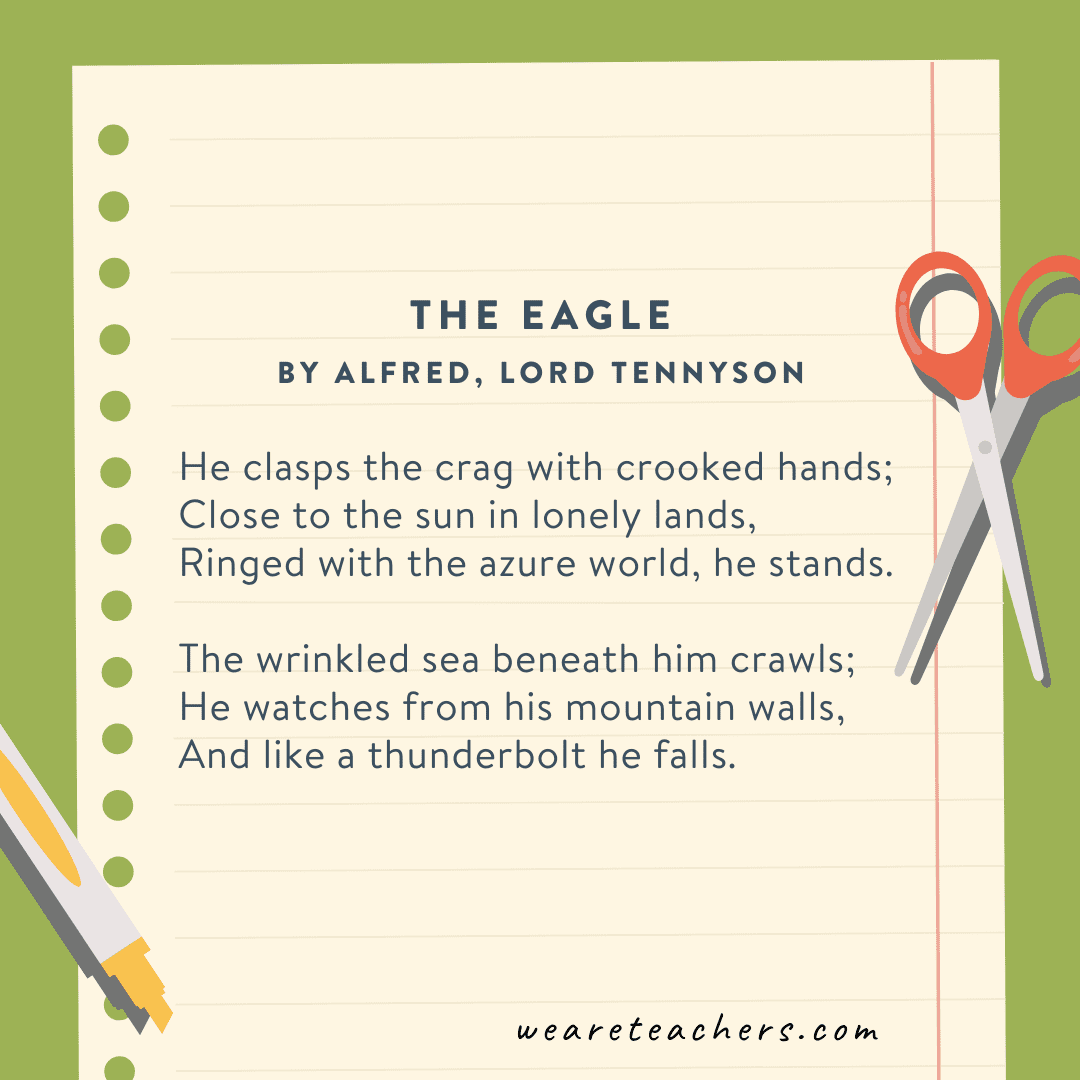
“He clasps the crag with crooked hands …”
Themes: Power, nature, isolation
Literary devices: Alliteration, imagery, personification
This short yet powerful poem paints a vivid picture of an eagle surveying its surroundings before diving. It’s a great example of how poets use strong imagery and alliteration to create intensity and can be used to discuss themes of strength and independence.
“See the pretty snowflakes, falling from the sky. / On the wall and housetops,
soft and thick they lie.”
Themes: Nature, winter, beauty
Literary devices: Rhyme, repetition, sensory imagery
This gentle winter poem uses simple language to capture the peaceful beauty of falling snow. It’s a sweet way to introduce younger students to rhyme and sensory details while encouraging them to describe seasonal experiences in their own words.
10. The Dolly by Jeanette Cheal
“The dolly sat upon the shelf / in the toy maker’s shop all by herself.”
Themes: Loneliness, disability, hope
Literary devices: Personification, rhyme, tone
This touching poem gives a doll human emotions, making it a wonderful example of personification. It’s a solid pick for discussing how writers create emotion in poetry and how objects can reflect human feelings.
11. The Snowflake by Margaret Elizabeth Sangster
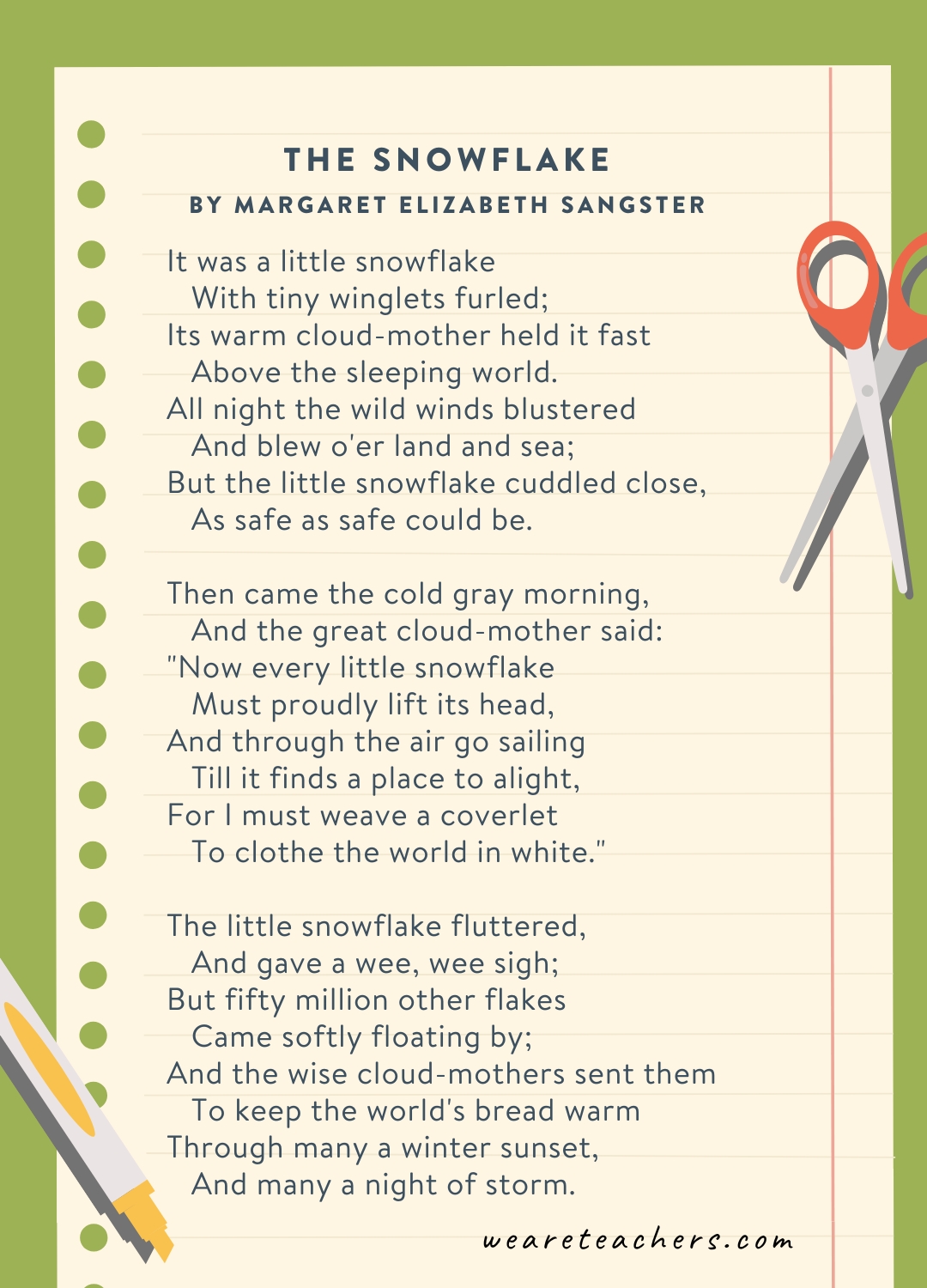
“It was a little snowflake …”
Themes: Nature, uniqueness, fleeting beauty
Literary devices: Imagery, personification, symbolism
This delicate poem captures the beauty and transience of a single snowflake, making it a great choice for discussing how poets use imagery to describe nature. It’s also a beautiful way to introduce students to themes of individuality and impermanence.
“Frosty is the morning / But the sun is bright …”
Themes: Joy, childhood, winter fun
Literary devices: Rhyme, rhythm, sensory imagery
This lively poem brings a winter morning to life, celebrating the thrill of sledding down a hill. It’s a great pick for exploring rhyme and rhythm while encouraging students to write about their own outdoor adventures.
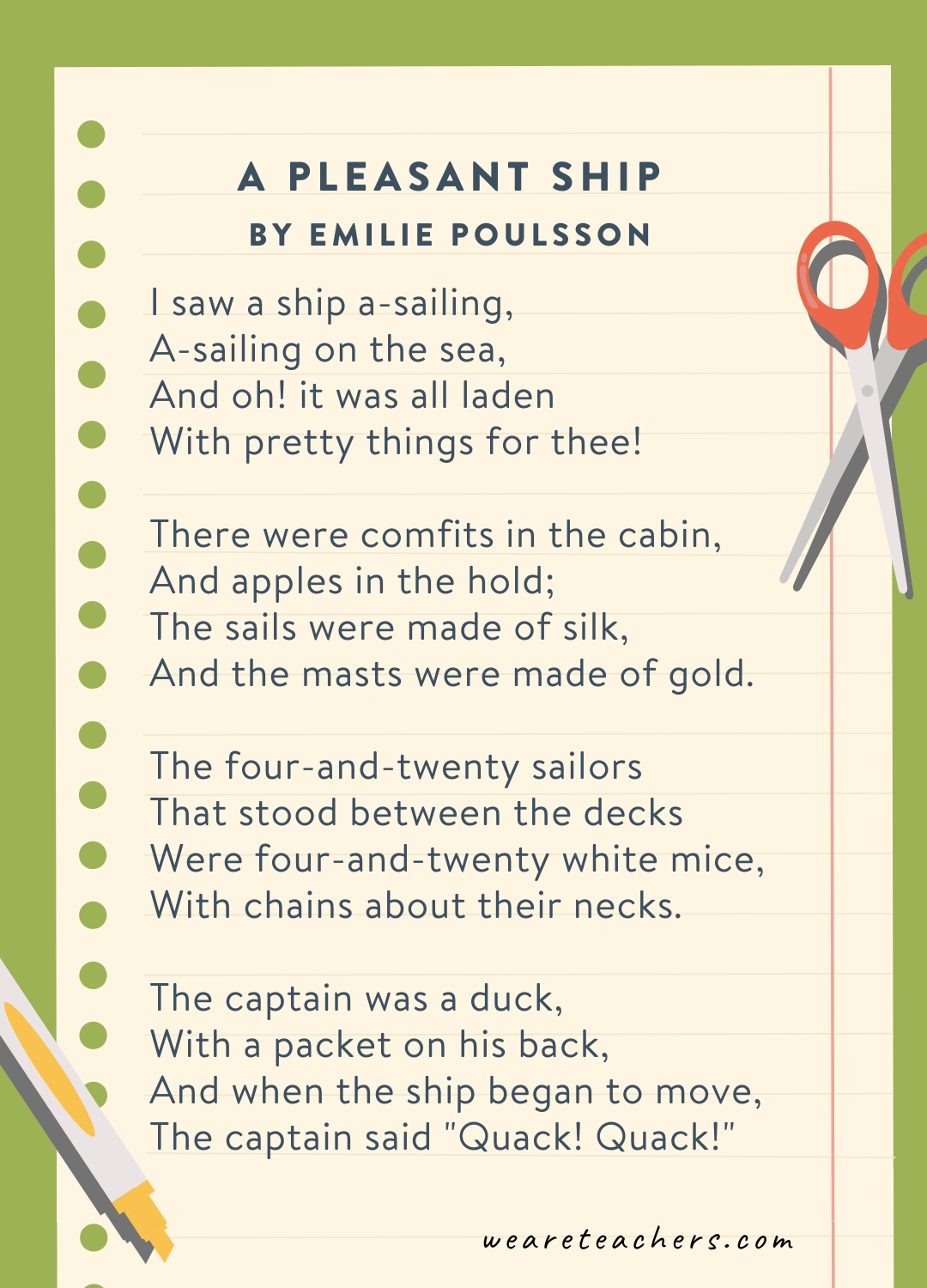
“I saw a ship a-sailing …”
Themes: Imagination, adventure, childhood wonder
Literary devices: Repetition, personification, rhyme
This whimsical poem turns a simple observation into a magical journey, making it a good way to explore imagination in poetry. It’s also useful for teaching how rhyme and repetition create a musical quality in verse.
“I know what I’d do.”
Themes: Kindness, generosity, optimism
Literary devices: Personification, metaphor, repetition
This uplifting poem imagines the speaker as a sunbeam spreading warmth and kindness, offering a wonderful lesson on empathy and positive action. It’s great for discussing how poets use metaphor to express deeper themes.
“Glad to see you, little bird / ’Twas your little chirp I heard …”
Themes: Nature, appreciation, companionship
Literary devices: Rhyme, imagery, tone
This gentle poem highlights the simple joy of noticing a sparrow’s presence, making it a good example of how poetry can find beauty in everyday moments. It’s perfect for exploring descriptive language and the theme of appreciating nature.
“But I’m not sure if it’s good. / It doesn’t have the things / my teacher says a poem should.”
Literary devices: Rhyme, irony, meta-poetry
This funny, self-aware poem pokes fun at poetry rules while celebrating the act of writing. It’s a humorous way to encourage students to experiment with their own poetry, showing that creativity matters just as much as structure.
“The spider wears a plain brown dress …”
Themes: Inner beauty, character, wisdom
Literary devices: Metaphor, contrast, symbolism
This thought-provoking poem contrasts outward appearance with inner goodness, using the humble spider as a metaphor. It’s a fantastic choice for discussing the theme of true beauty and how poets use simple imagery to convey deeper messages.
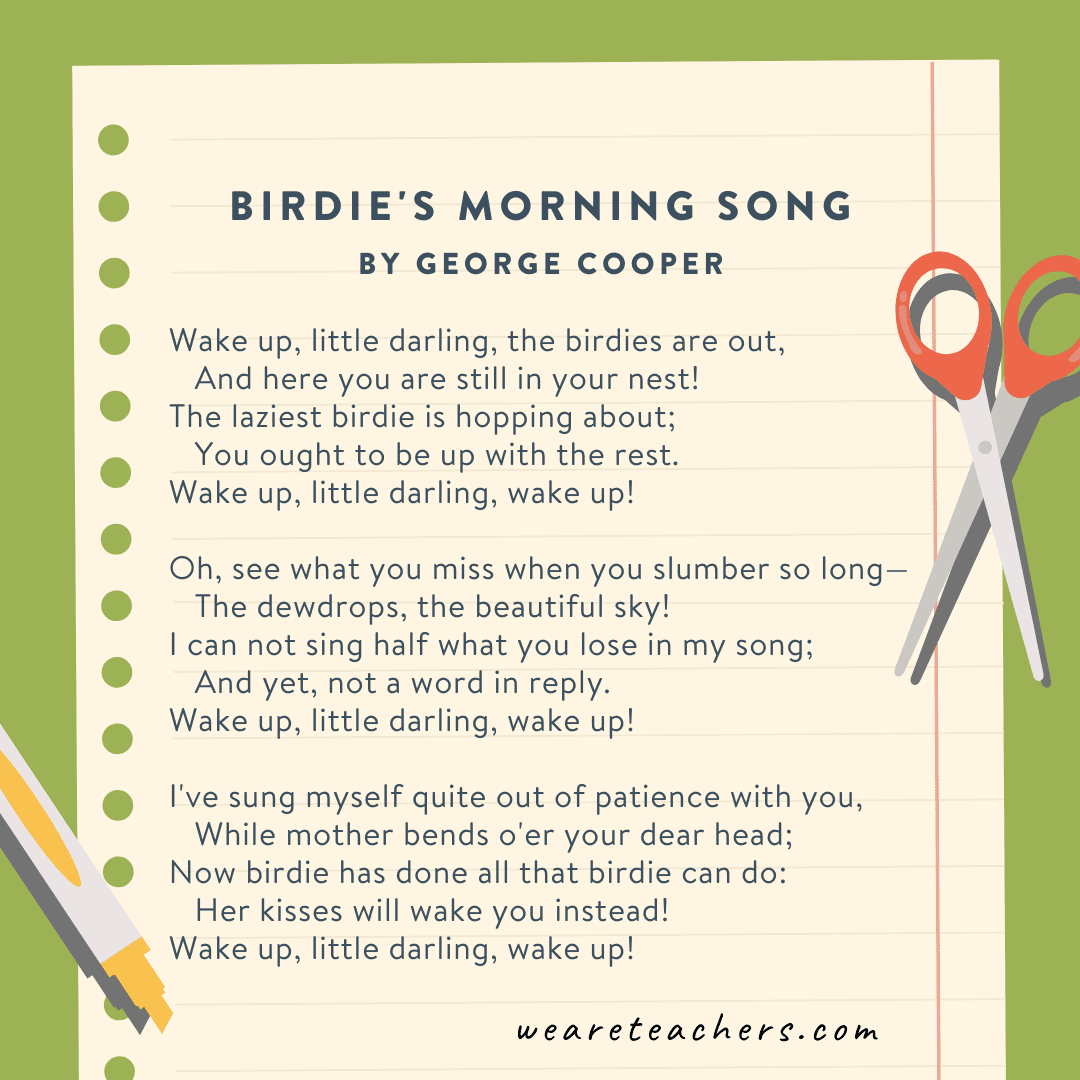
“Wake up, little darling, the birdies are out …”
Themes: Nature, joy, new beginnings
Literary devices: Rhyme, personification, repetition
This sweet, musical poem captures the cheerful start of a new day through the eyes of a bird. It’s perfect for introducing young students to rhyme and rhythm while sparking discussions about nature and morning routines.
19. Trees by Joyce Kilmer
“I think that I shall never see / A poem lovely as a tree …”
Themes: Nature, appreciation, spirituality
Literary devices: Rhyme, personification, metaphor
This well-known poem celebrates the beauty and grandeur of trees, personifying them to highlight their natural grace. It’s a great piece for discussing poetic structure, figurative language, and the theme of reverence for nature.
“There is a little maiden— / Who is she? Do you know?”
Themes: Positivity, kindness, character
Literary devices: Rhyme, imagery, tone
This uplifting poem highlights the power of a cheerful attitude, making it a good choice for discussing how poetry can convey moral lessons. It also serves as a good example of how tone and word choice shape the message of a poem.
“Which way does the wind blow? / And where does he go?”
Themes: Curiosity, nature, mystery
Literary devices: Personification, repetition, rhyme
This simple yet thoughtful poem captures a childlike curiosity about the wind’s movement, making it a good choice for discussing personification and how poetry can explore everyday wonders. It’s also useful for encouraging students to observe and describe nature in their own writing.
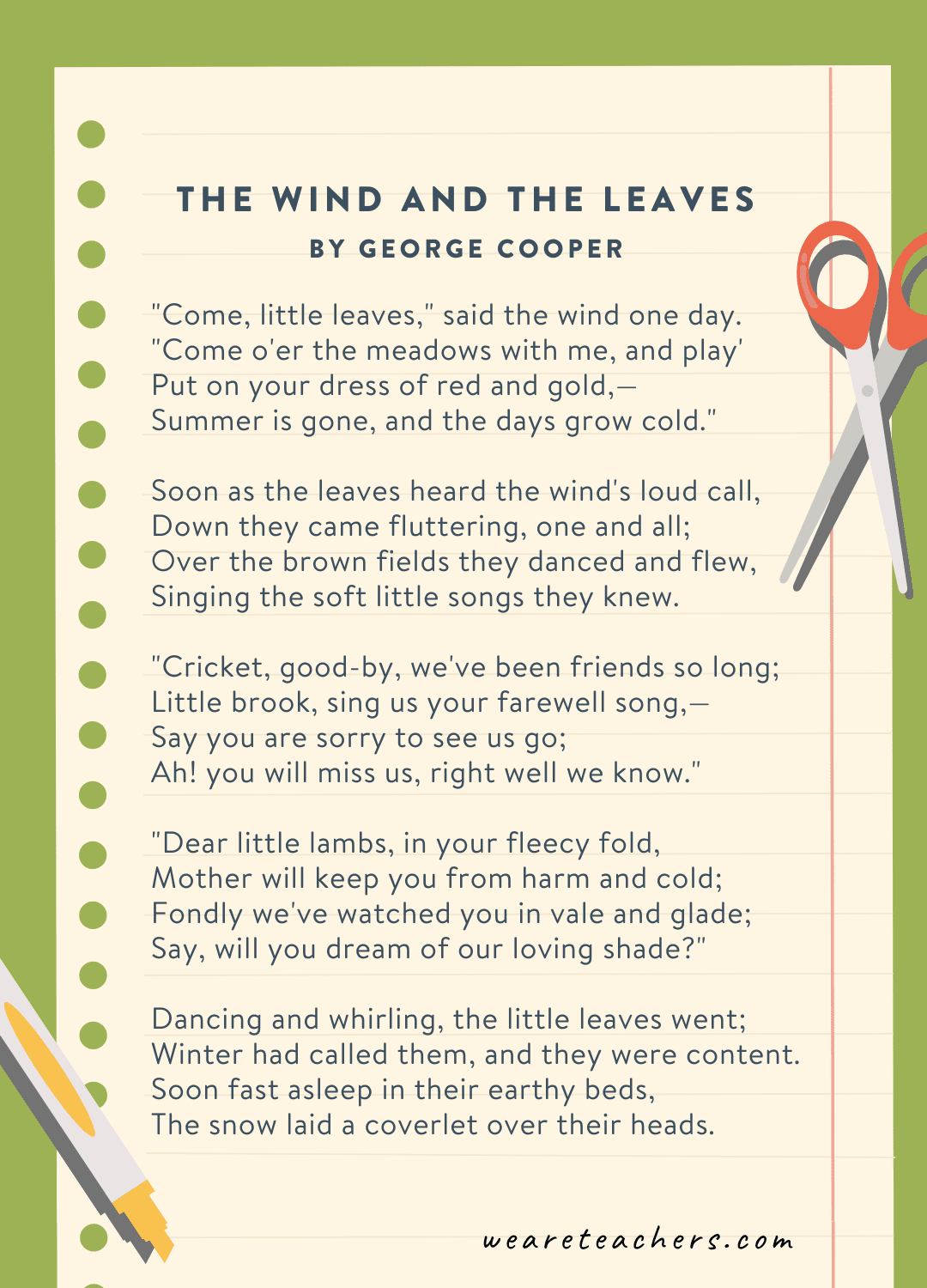
“‘Come, little leaves,’ said the wind one day.”
Themes: Change, seasons, nature’s cycle
Literary devices: Dialogue, personification, imagery
This charming poem tells a story of autumn using personification, making it a wonderful example of how poets bring nature to life. It’s perfect for teaching figurative language and for seasonal poetry activities.
23. Lullaby by Alfred, Lord Tennyson
“Sweet and low, sweet and low …”
Themes: Love, comfort, bedtime
Literary devices: Repetition, rhythm, imagery
This gentle lullaby poem has a calming rhythm and soft, flowing words, making it ideal for discussing how sound and structure influence mood. It’s great for exploring how poets use repetition, tone, and imagery to create emotion.
24. March by Mary Mapes Dodge
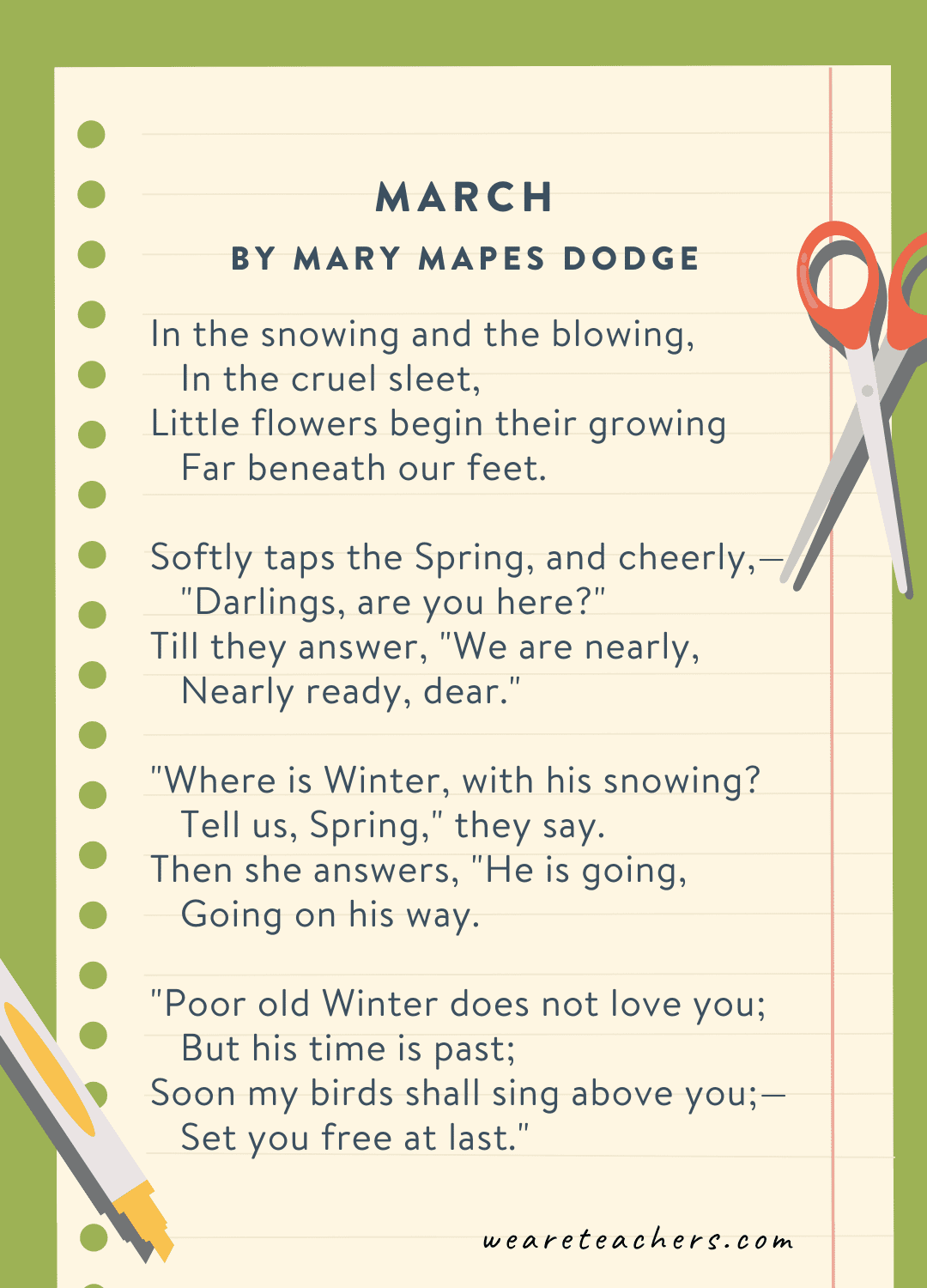
“In the snowing and the blowing …”
Themes: Weather, transition, resilience
Literary devices: Rhyme, repetition, imagery
This lively poem captures the unpredictable nature of March, making it a solid pick for exploring how rhythm and word choice reflect movement and energy. It’s also useful for discussing seasonal changes and how poetry can describe the weather in a vivid way.
25. The Rabbit by Elizabeth Madox Roberts
“When they said the time to hide was mine / I hid back under a thick grape vine.”
Themes: Childhood, play, nature
Literary devices: Imagery, perspective, rhythm
This playful poem brings readers into the world of a child hiding in a game, making it a good example of how poetry captures everyday moments. It’s perfect for discussing perspective in poetry and encouraging students to write about their own childhood experiences.
“I scrape a leg / Or skin a knee.”
Themes: Adventure, childhood, nature
Literary devices: Rhyme, repetition, sensory imagery
This lively poem captures the thrill and minor mishaps of climbing trees, making it a fitting piece for discussing sensory imagery and how poetry reflects childhood experiences. It’s also useful for exploring rhythm and rhyme in storytelling poetry.
“I studied my tables over and over, and backward and forward, too …”
Themes: Embarrassment, learning, perseverance
Literary devices: Narrative structure, rhythm, irony
This relatable poem humorously recounts the frustration of making a mistake despite careful preparation. It’s a great way to discuss how poetry can tell a story and how humor can be used to express universal experiences.
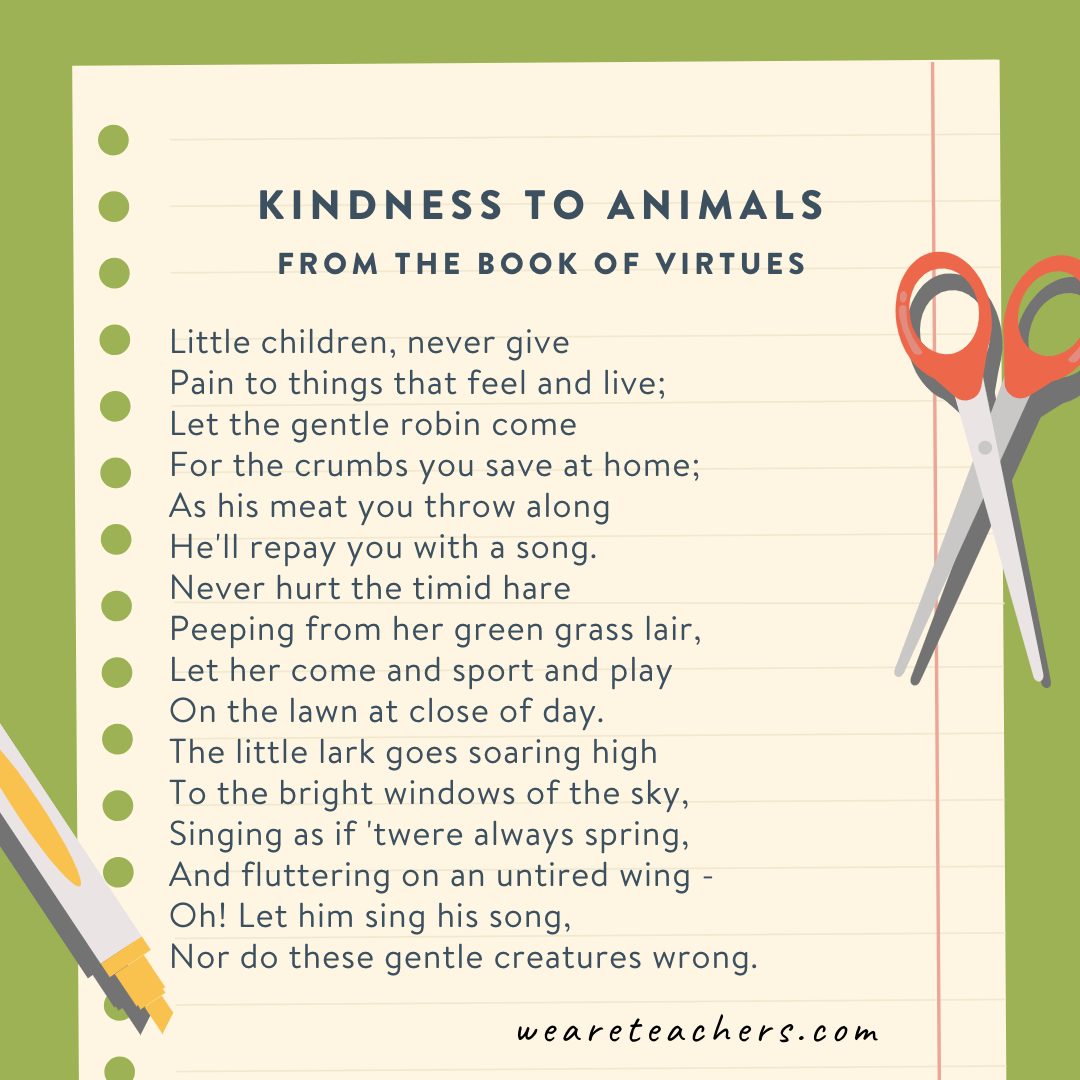
“Little children, never give / Pain to things that feel and live …”
Themes: Compassion, morality, responsibility
Literary devices: Rhyme, repetition, direct address
This short and meaningful poem teaches an important lesson about kindness toward animals, making it an ideal piece for discussions on poetry with moral themes. It’s also useful for exploring how rhyme and repetition reinforce a message.
29. Be Kind by Alice Joyce Davidson
“Just a little bit of kindness / Can go a long, long way …”
Themes: Empathy, generosity, positive actions
Literary devices: Rhyme, repetition, uplifting tone
This poem encourages kindness through simple, heartfelt language, making it a great choice for discussing how poetry can inspire positive behavior. It also serves as a good example of how structure and repetition create an impactful message.
“No one throws a pencil / at the ceiling of the class.”
Themes: Humor, mischief, school life
Literary devices: Rhyme, irony, exaggeration
This playful poem humorously describes the antics that happen when the teacher isn’t watching, making it a fun way to engage students with poetry. It’s perfect for discussing exaggeration, humor in poetry, and how rhyme enhances comedic effect.
“Jellicle Cats come out tonight / Jellicle Cats come one come all.”
Themes: Mystery, movement, playfulness
Literary devices: Rhyme, repetition, imagery
This energetic poem creates a lively, almost musical atmosphere as it describes the Jellicle Cats. It’s great for discussing how rhythm and repetition build momentum in poetry and for introducing students to Eliot’s playful use of language.
“Whose woods these are I think I know …”
Themes: Reflection, solitude, duty
Literary devices: Rhyme, imagery, symbolism
This well-known poem captures a quiet, reflective moment in nature while hinting at deeper meanings of responsibility and rest. It’s an excellent piece for discussing symbolism, rhyme scheme (the interlocking rubaiyat), and how poetry evokes emotion through simplicity.
33. Your World by Georgia Douglas Johnson
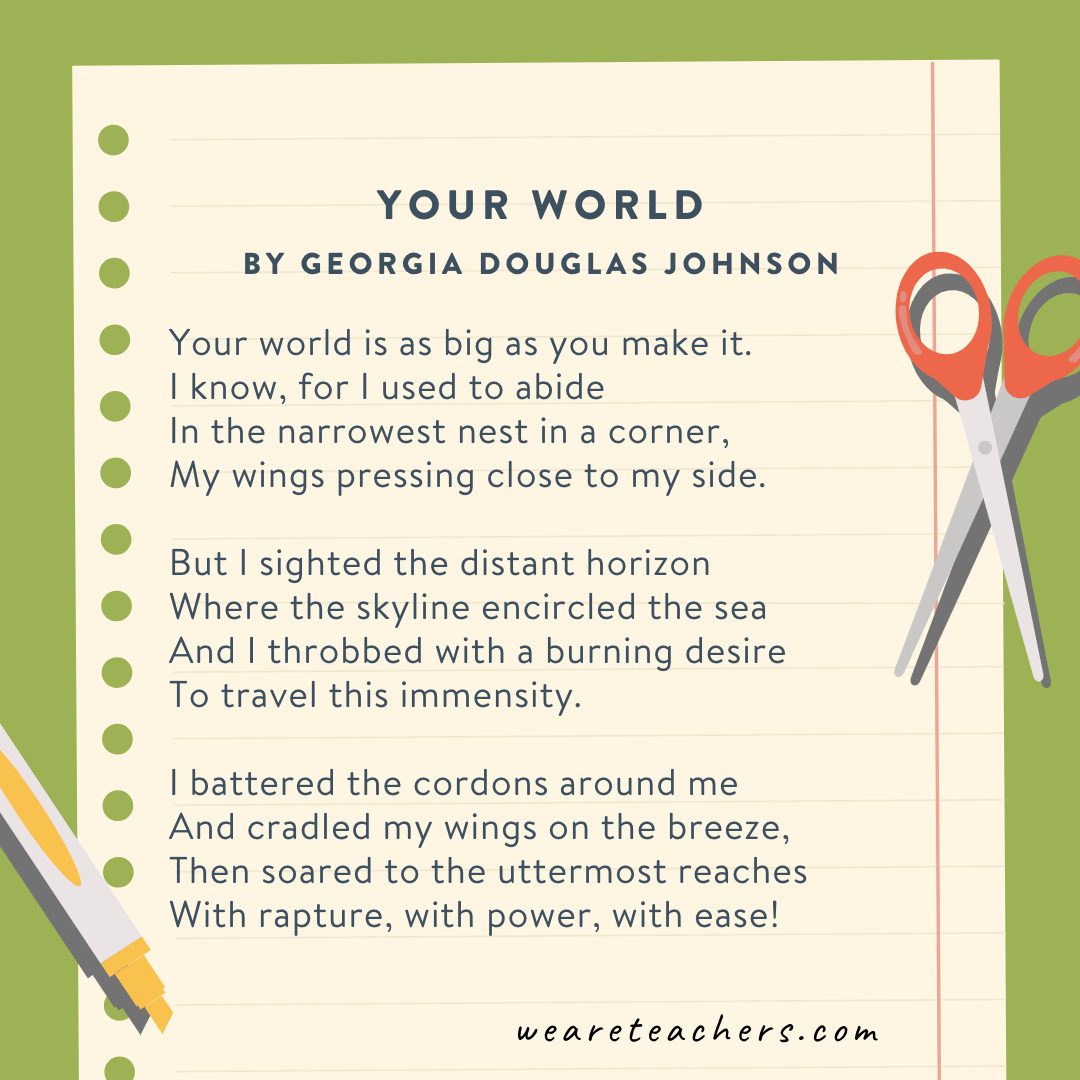
“Your world is as big as you make it.”
Themes: Ambition, courage, personal growth
Literary devices: Metaphor, imagery, motivational tone
This uplifting poem encourages readers to break free from limitations and embrace possibilities. It’s a solid choice for discussing metaphor and inspirational themes, as well as for connecting poetry to students’ personal dreams and aspirations.
“They went to sea in a Sieve, they did / In a sieve they went to sea …”
Themes: Adventure, nonsense, determination
Literary devices: Rhyme, repetition, nonsense words
This delightful nonsense poem is full of playful language and absurd imagery, making it ideal for exploring rhyme, rhythm, and the genre of nonsense poetry. It’s also good for sparking creativity and imaginative storytelling.
“It was time to go.”
Themes: Change, instinct, nature’s cycle
Literary devices: Personification, imagery, foreshadowing
This beautifully written poem captures the quiet inevitability of seasonal change through the migration of geese. It’s a great piece for discussing personification and how poets use nature to explore deeper themes of instinct and transition.
“I’m making a pizza the size of the sun / a pizza that’s sure to weigh more than a ton …”
Themes: Exaggeration, humor, creativity
Literary devices: Hyperbole, rhyme, repetition
This fun and over-the-top poem takes an everyday food and turns it into a massive, ridiculous creation. It’s wonderful for teaching hyperbole and rhyme, and it can inspire students to write their own exaggerated poems about food or other familiar topics.
“Went for a ride in a flying shoe …”
Themes: Adventure, nonsense, imagination
Literary devices: Rhyme, rhythm, nonsense words
This whimsical poem takes readers on a wild, dreamlike journey in a flying shoe, making it perfect for exploring nonsense poetry and rhythm. It’s also a good way to encourage students to embrace creativity and playful language in their own writing.
38. My Shadow by Robert Louis Stevenson
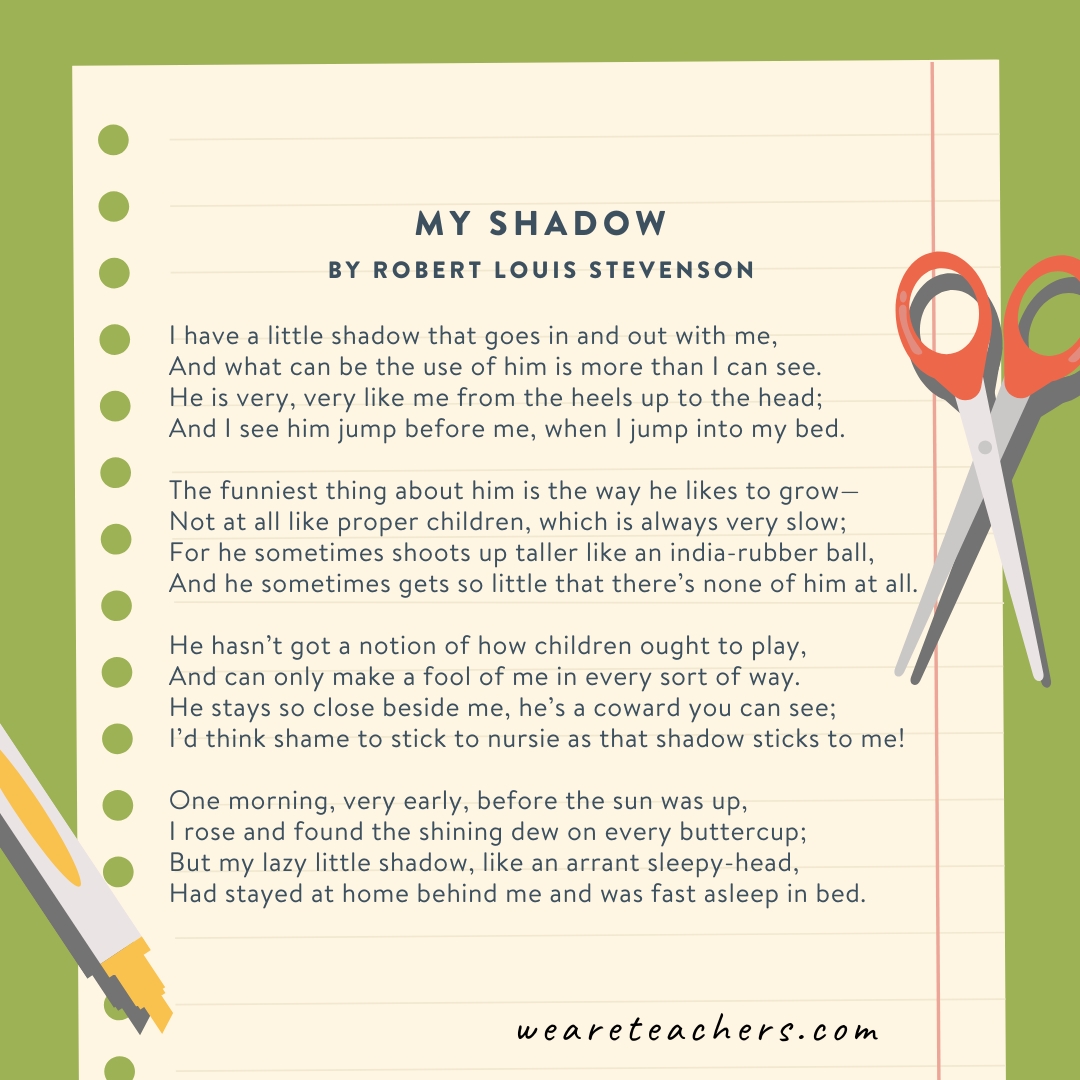
“I have a little shadow that goes in and out with me …”
Themes: Childhood, curiosity, observation
Literary devices: Personification, rhyme, rhythm
This classic poem captures a child’s fascination with their own shadow, making it a solid piece for discussing personification and how poetry can reflect the way children observe the world. It’s also useful for exploring rhyme and rhythm in traditional poetry.
“’Twas brillig, and the slithy toves / Did gyre and gimble in the wabe …”
Themes: Courage, imagination, adventure
Literary devices: Alliteration, portmanteau, rhyme
This famous nonsense poem is full of made-up words and vivid imagery, making it perfect for teaching creative writing, wordplay, and how meaning can be inferred through context. It’s also good for introducing literary devices like alliteration and neologisms.
“There’s a new kid on the block / and boy, that kid is tough …”
Themes: Humor, exaggeration, school life
Literary devices: Hyperbole, rhyme, tone
This humorous poem describes an unbelievably tough new student, using exaggeration to build suspense and surprise. It’s a fun way to teach hyperbole and rhyme while also engaging students with a relatable school setting.
41. The Tyger by William Blake
“Tyger Tyger, burning bright / In the forests of the night …”
Themes: Creation, power, mystery, duality
Literary devices: Symbolism, repetition, rhyme, alliteration
This classic poem questions the nature of creation, using the tiger as a powerful and almost divine figure. It’s great for discussing symbolism, contrasting imagery (the tiger vs. the lamb in Blake’s poetry), and how repetition enhances meaning.
“I’m going out to fetch the little calf / That’s standing by the mother. It’s so young …”
Themes: Nature, simplicity, renewal
Literary devices: Imagery, repetition, conversational tone
This gentle, welcoming poem invites the reader into a quiet moment in nature. It’s perfect for exploring Frost’s signature style of simplicity and natural imagery, as well as discussing how poetry can capture everyday moments beautifully.
“The outlook wasn’t brilliant for the Mudville nine that day: / The score stood four to two, with but one inning more to play …”
Themes: Confidence, disappointment, sportsmanship
Literary devices: Narrative structure, rhythm, suspense, irony
This dramatic, beloved baseball poem builds excitement with its storytelling and ultimately delivers a twist ending. It’s fantastic for analyzing narrative poetry, discussing how poets use suspense, and exploring themes of confidence and humility.
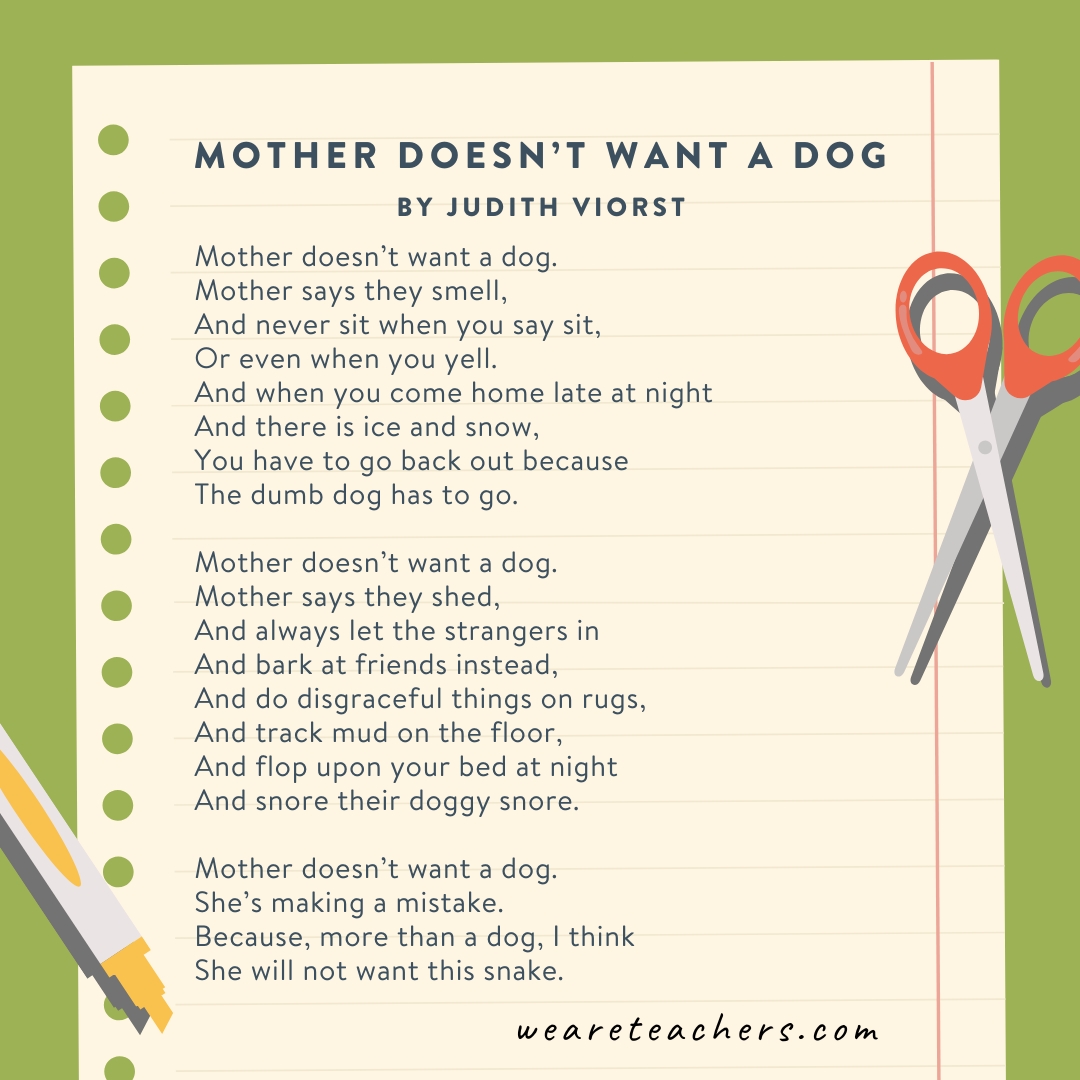
“Mother says they smell …”
Themes: Childhood, humor, family dynamics
Literary devices: Rhyme, exaggeration, repetition
This funny and relatable poem captures a child’s frustration with their parent’s refusal to get a pet. It’s a great pick for discussing how humor is used in poetry, how rhyme enhances playful storytelling, and how kids’ voices can shine through in writing.
“How doth the little crocodile / Improve his shining tail …”
Themes: Deception, nature, satire
Literary devices: Parody, rhyme, imagery
This clever poem is a parody of Isaac Watts’ moralistic poetry, replacing a hardworking bee with a deceptive crocodile. It’s perfect for discussing satire, poetic parody, and how writers can subvert expectations in their work.
“For want of a nail, the shoe was lost.”
Themes: Consequences, cause and effect, wisdom
Literary devices: Repetition, parallel structure, aphorism
This well-known proverb-turned-poem teaches a lesson about how small actions can have big consequences. It’s great for discussing cause and effect, historical applications (such as in leadership or war), and how repetition reinforces a message in poetry.
“No one can tell me / Nobody knows / Where the wind comes from / Where the wind goes.”
Themes: Curiosity, wonder, nature
Literary devices: Rhyme, repetition, personification
This whimsical poem captures a child’s curiosity about the wind and its mysterious movements. It’s a lovely piece for exploring how poetry embraces wonder and encourages students to ask their own big questions about the world.
48. The Swing by Robert Louis Stevenson
“How do you like to go up in a swing / Up in the air so blue?”
Themes: Joy, childhood, movement
Literary devices: Rhyme, repetition, imagery
This nostalgic poem beautifully captures the simple thrill of swinging, using vivid imagery and rhythm to mirror the motion. It’s a great example of how poetry can reflect the universal experiences of childhood.
49. Magic by Shel Silverstein
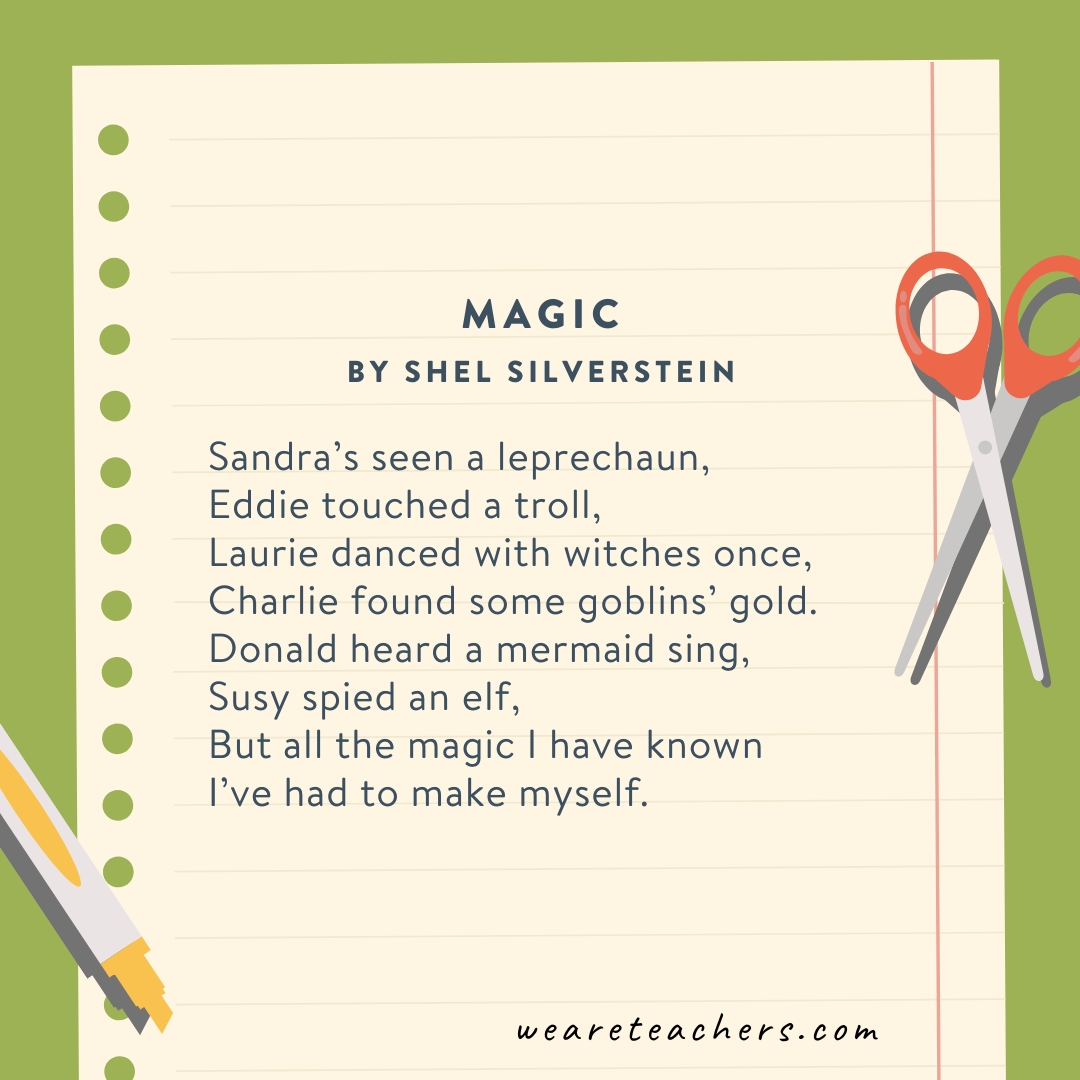
“Sandra’s seen a leprechaun …”
Themes: Imagination, belief, wonder
Literary devices: Rhyme, humor, playful tone
This fun, imaginative poem embraces the idea that magic exists for those who believe in it. It’s perfect for discussions about the power of perspective, creative writing, and how poets use playful language to engage young readers.
“Two roads diverged in a yellow wood / And sorry I could not travel both …”
Themes: Choices, individuality, life’s journey
Literary devices: Metaphor, symbolism, rhyme
This famous poem reflects on decision-making and the impact of choices on life’s path. It’s a great piece for discussing metaphor (the roads as life choices), symbolism, and how poetry can express deep personal reflection.
51. Fog by Carl Sandburg
“The fog comes on little cat feet.”
Themes: Nature, observation, mystery
Literary devices: Metaphor, imagery, personification
This short but powerful poem uses a simple metaphor to describe fog as a silent, creeping cat. It’s excellent for discussing how poets use minimal words to create vivid imagery and evoke a specific mood.
“I never saw a Purple Cow / I never hope to see one.”
Themes: Humor, absurdity, creativity
Literary devices: Rhyme, irony, satire
This playful nonsense poem is a fun way to introduce humor in poetry and discuss how poets use exaggeration and absurdity to make a point. It’s also great for exploring rhyme and meter in short verse.
53. Sick by Shel Silverstein
“My mouth is wet, my throat is dry / I’m going blind in my right eye.”
Themes: Humor, exaggeration, childhood antics
Literary devices: Hyperbole, rhyme, irony
This hilarious poem tells the story of a child faking illness to skip school, only to realize it’s Saturday. It’s a solid example of hyperbole and irony in poetry, making it a fun piece to discuss how poets use humor to engage readers.
“Said the Duck to the Kangaroo / ‘Good gracious! how you hop!’”
Themes: Friendship, adventure, nonsense
Literary devices: Rhyme, repetition, dialogue
This delightful nonsense poem tells the quirky tale of a duck and a kangaroo who want to travel together. It’s a fun way to explore rhyme, rhythm, and the genre of nonsense poetry while encouraging creative storytelling.
55. Dreams by Langston Hughes
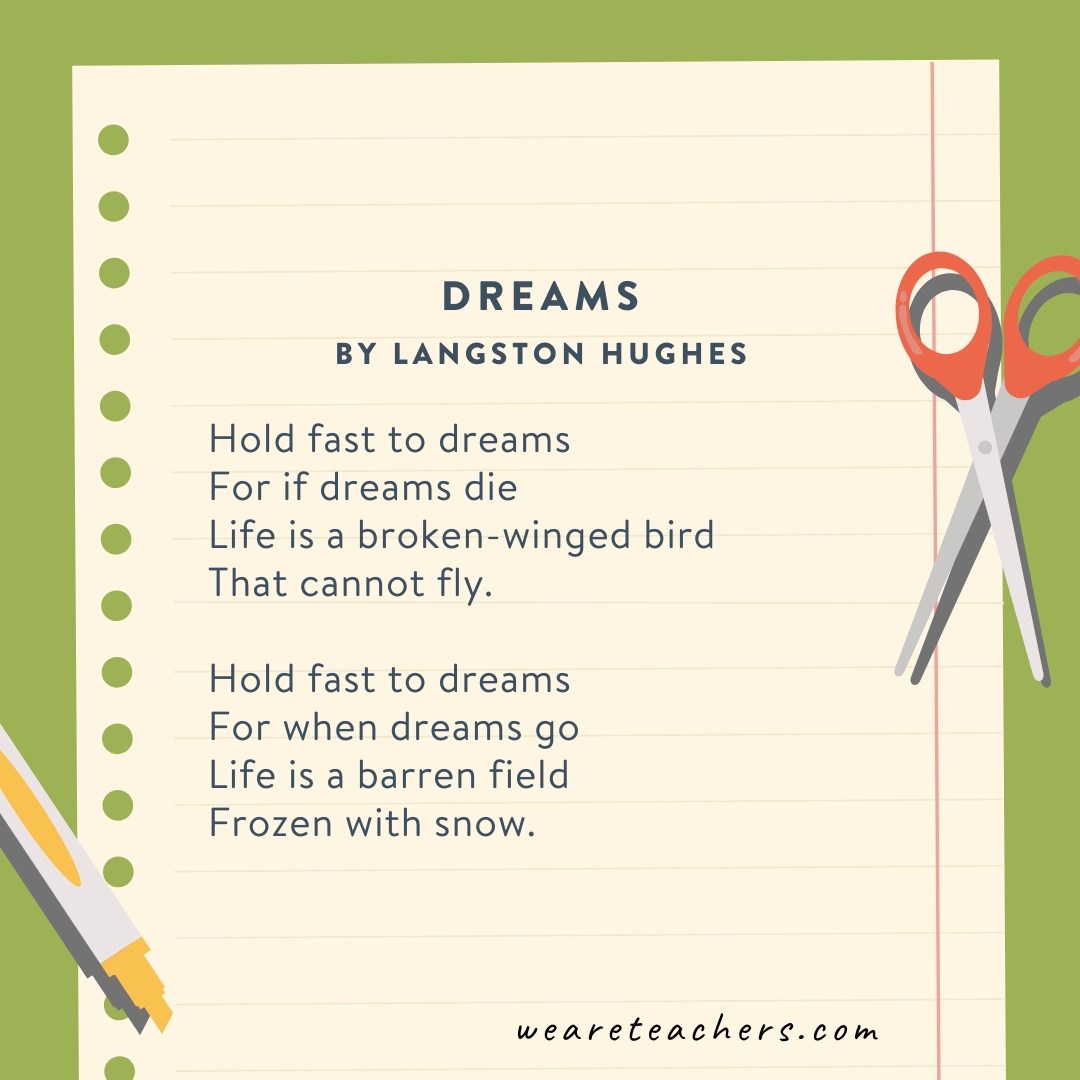
“Hold fast to dreams …”
Themes: Hope, perseverance, aspirations
Literary devices: Metaphor, repetition, symbolism
This short but meaningful poem encourages readers to hold onto their dreams, using strong metaphors to highlight their importance. It’s perfect for discussing figurative language, theme, and how poetry can inspire resilience and ambition.
Get my free printable poetry worksheet bundle!
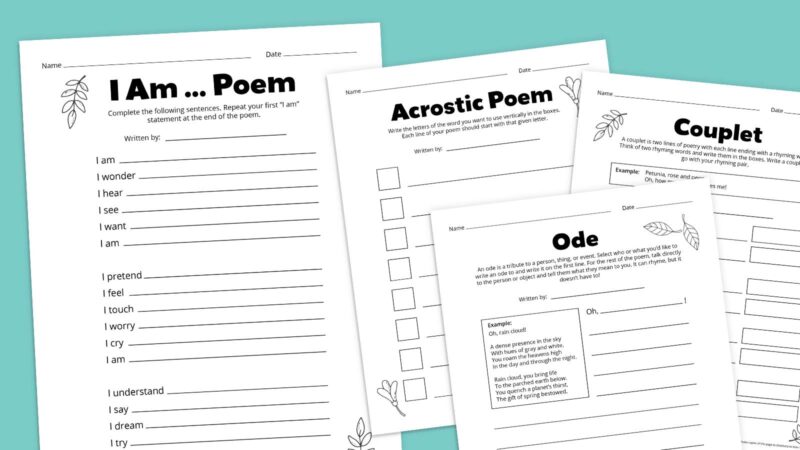
Are you ready to bring these activities to your classroom? Click the button below to receive our poetry worksheet bundle and get started!
If you liked these poems for 3rd graders, be sure to subscribe to our newsletters to find out when new articles like this are posted.
